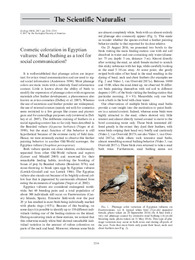Por favor, use este identificador para citar o enlazar este ítem:
https://hdl.handle.net/11000/6006Registro completo de metadatos
| Campo DC | Valor | Lengua/Idioma |
|---|---|---|
| dc.contributor.author | Overveld, Thijs van | - |
| dc.contributor.author | de la Riva, Manuel | - |
| dc.contributor.author | Donázar, José Antonio | - |
| dc.contributor.other | Departamentos de la UMH::Biología Aplicada | es |
| dc.date.accessioned | 2020-05-12T09:19:07Z | - |
| dc.date.available | 2020-05-12T09:19:07Z | - |
| dc.date.created | 2017-05-08 | - |
| dc.date.issued | 2020-05-12 | - |
| dc.identifier.issn | 1939-9170 | - |
| dc.identifier.uri | http://hdl.handle.net/11000/6006 | - |
| dc.description.abstract | It is well‐established that plumage colors are important for avian visual communication and are used to signal social information (Andersson 1994). Most plumage colors are static traits with a relatively fixed information content. Little is known about the ability of birds to modify the expression of plumage colors with exogenous materials after feather development, a phenomenon also known as avian cosmetics (Delhey et al. 2007). Whereas the use of secretions and feather powder are widespread, the use of external sources (mainly red soil) for cosmetics seem restricted to a few groups like cranes and ptarmigans and for camouflage purposes only (reviewed in Delhey et al. 2007). The deliberate staining of feathers in a social signaling context has so far only been described in the Bearded vulture (Gypaetus barbatus) (Negro et al. 1999), but the exact function of this behavior is still hypothetical because of the extreme rarity of field data. Hence, we were extremely excited to observe this feather painting behavior in another Old‐World scavenger, the Egyptian vulture (Neophron percnopterus) | es |
| dc.description.sponsorship | Spanish Ministry of Economy and Competitiveness and EU/FEDER). Grant Number: CGL2015‐66966‐C2‐1‐2‐R | - |
| dc.format | application/pdf | es |
| dc.format.extent | 3 | es |
| dc.language.iso | eng | es |
| dc.rights | info:eu-repo/semantics/openAccess | es |
| dc.subject.other | 573 - Biología general y teórica | es |
| dc.title | Cosmetic coloration in Egyptian vultures: Mud bathing as a tool for social communication? | es |
| dc.type | info:eu-repo/semantics/article | es |
| dc.identifier.doi | 10.1002/ecy.1840 | - |
| dc.relation.publisherversion | https://doi.org/10.1002/ecy.1840 | - |

Ver/Abrir:
12-van Overvel et al 2017 Ecology.pdf
1,27 MB
Adobe PDF
Compartir:
 La licencia se describe como: Atribución-NonComercial-NoDerivada 4.0 Internacional.
La licencia se describe como: Atribución-NonComercial-NoDerivada 4.0 Internacional.
.png)